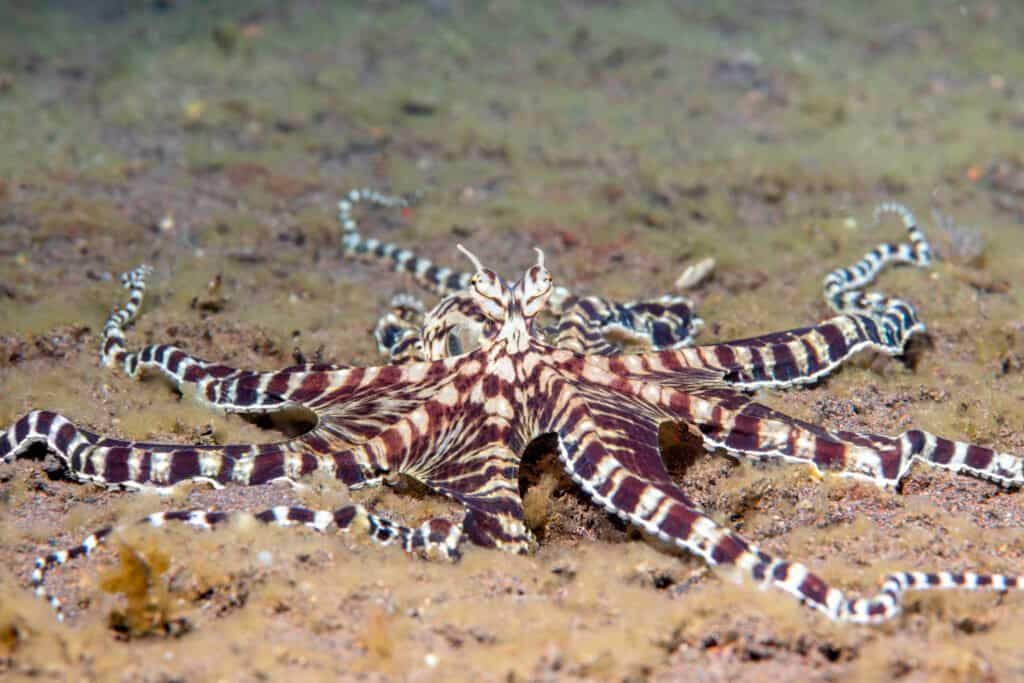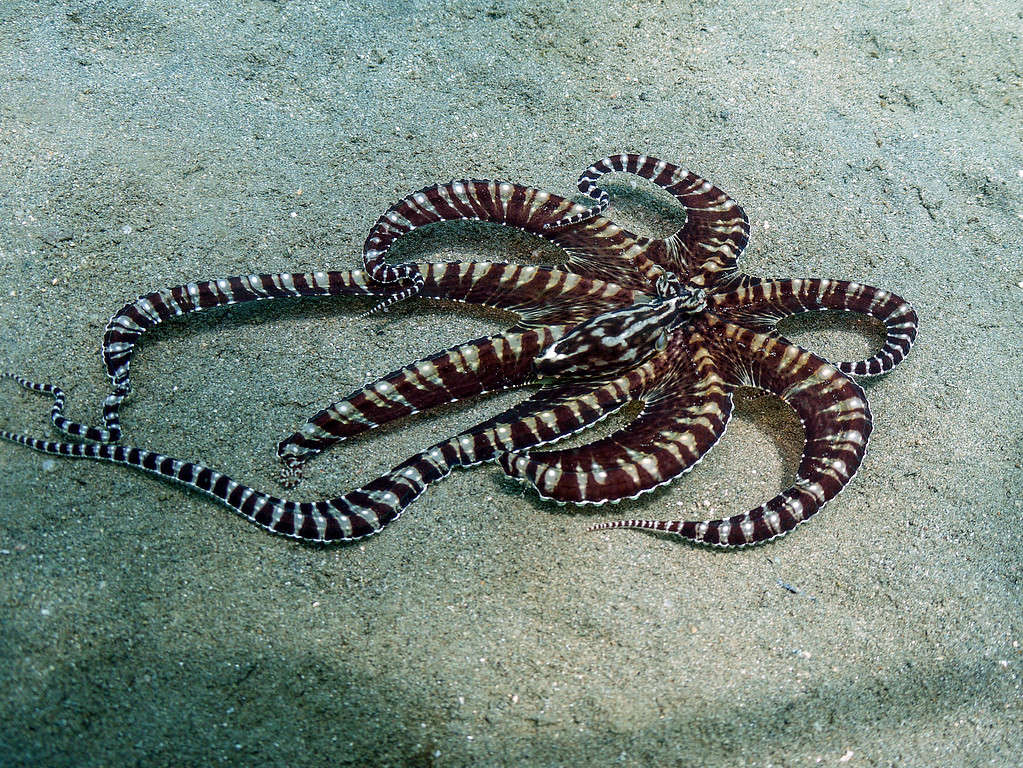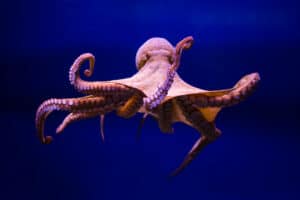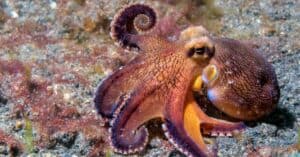Camouflage is one of nature’s most common forms of defense. When an animal can blend into its environment or mimic something else, it can escape predators peacefully. Or it can quietly sneak up on and catch prey of its own. However, some animal species go above and beyond the usual deceit. The mimic octopus is the ultimate disguise artist of the animal kingdom.
What is the Mimic Octopus?

We have only known about the mimic octopus, the master of disguise, since 1998.
©Joe Belanger/Shutterstock.com
We’ve only known about the mimic octopus (Thaumoctopus mimicus) since it was discovered in the shallow waters around Indonesia in 1998. It makes its home in shallow and murky waters. The mimic octopus glides across the sand, searching for its prey. Its diet consists of small fish, crustaceans, and worms.
This unique sea creature can shapeshift into 15 different species that we know of. This is astounding, considering most animal species can only mimic one other type of animal.
What Animals Can the Mimic Octopus Imitate?
The mimic octopus changes its color, texture, and even its shape to disguise itself into animals such as sea snakes and lionfish. What’s more, the mimic octopus can shift its shape in an instant.
The mimic octopus is a small specimen and only reaches about two feet in length. Its natural color is pale brown with brown and white stripes. However, the octopus has color-changing cells called chromatophores. Beyond being able to change its color or texture, the mimic octopus can move its arms to appear to be a different animal entirely.
What Species Have Divers Witnessed the Mimic Octopus Impersonating?

A mimic octopus is disguised here as a flatfish swimming across the murky ocean bottom.
©Velvetfish/iStock via Getty Images
Many of the creatures the mimic octopus impersonates are venomous. This sends predators fleeing from sight when they think a venomous species is near. For example, the mimic octopus has been seen putting six of its arms down a hole on the ocean floor, with its two remaining arms sticking out of the hole. This makes it resemble a poisonous sea snake with bands along its body.
It can imitate a jellyfish by swimming close to the surface. Next, it slowly sinks to the bottom while spreading its arms evenly around its body, looking just like the shape of a venomous jellyfish.
The little octopus is also known to pull its arms behind its body and swim along the ocean floor, looking like a venomous flatfish. Another highlight of its mimicry is when it imitates a lionfish. It does this by swimming along, making its arms appear to be the venomous spikes of the lionfish.
It also uses its powers of disguise to hunt for food. Imitating a crab’s mate can lure other crabs to it and feed on them.
These are some of the different species the mimic octopus has been seen impersonating. (However, keep in mind that this resourceful cephalopod may be able to impersonate even more animals that we haven’t yet witnessed.)
- Lionfish
- Sea snake
- Stingrays
- Sole (Flatfish)
- Jellyfish
- Sea anemones
- Mantis shrimp
- Brittle stars
- Giant crabs
- Seahorses
- Crocodile snake eels
Are Mimic Octopuses Intelligent?

The mimic octopus can change its shape at a moment’s notice.
©Jenhung Huang/iStock via Getty Images
Octopuses are known for their intelligence, and the mimic octopus is no exception. Its ability to rapidly change form to copy other animals, even animals that are not currently present, shows remarkable intelligence. It’s smart enough to know which type of creature serves it the best to mimic at any given moment. And it can transform at a moment’s notice.
Amazingly, researchers have seen the mimic octopus be able to choose which animal to mimic based on which would be the most threatening to a predator. Scientists have seen the mimic octopus imitate a banded sea snake to ward off an attack by damselfishes. Banded sea snakes are known to eat damselfishes.
Why Might the Mimic Octopus Have Superior Disguise Abilities?
Scientists believe that the mimic octopus had to up its disguise game due to its environment. While many species of octopus live in habits with lots of hiding places, such as coral reefs, the mimic octopus lives out in the open on the ocean floor. Since it can’t hide as easily as other species of octopus, the mimic octopus has developed superior camouflage abilities.
Who Copies the Mimic Octopus?
In 2011, researchers discovered the mimic octopus has its own mimic. The harlequin jawfish (Stalix histrio) can match its coloring to the octopus as it closely follows it, making the smaller fish nearly indistinguishable from the octopus.
The photo featured at the top of this post is © Joe Belanger/Shutterstock.com
Thank you for reading! Have some feedback for us? Contact the AZ Animals editorial team.






